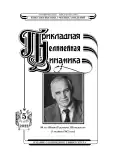Magnetoimpedance modulation in a planar magnetoelectric ferromagnet - piezoelectric heterostructure
- 作者: Burdin D.A.1, Chashin D.V.1, Ekonomov N.A.1, Fetisov Y.K.1
-
隶属关系:
- Federal State Budget Educational Institution of Higher Education «MIREA - Russian Technological University»
- 期: 卷 30, 编号 5 (2022)
- 页面: 554-562
- 栏目: Articles
- URL: https://journals.rcsi.science/0869-6632/article/view/252099
- DOI: https://doi.org/10.18500/0869-6632-003004
- EDN: https://elibrary.ru/ROMWUU
- ID: 252099
如何引用文章
全文:
详细
作者简介
Dmitry Burdin
Federal State Budget Educational Institution of Higher Education «MIREA - Russian Technological University»78, Vernadsky Ave., Moscow, 119454
Dmitry Chashin
Federal State Budget Educational Institution of Higher Education «MIREA - Russian Technological University»78, Vernadsky Ave., Moscow, 119454
Nikolay Ekonomov
Federal State Budget Educational Institution of Higher Education «MIREA - Russian Technological University»78, Vernadsky Ave., Moscow, 119454
Yuri Fetisov
Federal State Budget Educational Institution of Higher Education «MIREA - Russian Technological University»78, Vernadsky Ave., Moscow, 119454
参考
- Knobel M., Pirota K. R. Giant magnetoimpedance: concepts and recent progress // J. Magn. Magn. Mater. 2002. Vol. 242-245, no. 1. P. 33-40. doi: 10.1016/S0304-8853(01)01180-5.
- Panina L. V., Mohri K. Magneto-impedance effect in amorphous wires // Appl. Phys. Lett. 1994. Vol. 65, no. 9. P. 1189-1191. doi: 10.1063/1.112104.
- Panina L. V., Mohri K., Uchiyama T., Noda M., Bushida K. Giant magneto-impedance in Corich amorphous wires and films // IEEE Trans. Magn. 1995. Vol. 31, no. 2. P. 1249-1260. doi: 10.1109/20.364815.
- Phan M.-H., Peng H.-X. Giant magnetoimpedance materials: Fundamentals and applications // Progress in Materials Science. 2008. Vol. 53, no. 2. P. 323-420. doi: 10.1016/j.pmatsci.2007.05.003.
- Shen L. P., Uchiyama T., Mohri K., Kita E., Bushida K. Sensitive stress-impedance micro sensor using amorphous magnetostrictive wire // IEEE Trans. Magn. 1997. Vol. 33, no. 5. P. 3355-3357. doi: 10.1109/20.617942.
- Gazda P., Nowicki M., Szewczyk R. Comparison of stress-impedance effect in amorphous ribbons with positive and negative magnetostriction // Materials. 2019. Vol. 12, no. 2. P. 275. doi: 10.3390/ma12020275.
- Nan C.-W., Bichurin M. I., Dong S., Viehland D., Srinivasan G. Multiferroic magnetoelectric composites: Historical perspective, status, and future directions // J. Appl. Phys. 2008. Vol. 103, no. 3. P. 031101. doi: 10.1063/1.2836410.
- Wang W., Wang Z., Luo X., Tao J., Zhang N., Xu X., Zhou L. Capacitive type magnetoimpedance effect in piezoelectric-magnetostrictive composite resonator // Appl. Phys. Lett. 2015. Vol. 107, no. 17. P. 172904. doi: 10.1063/1.4934821.
- Leung C. M., Zhuang X., Xu J., Li J., Zhang J., Srinivasan G., Viehland D. Enhanced tunability of magneto-impedance and magneto-capacitance in annealed Metglas/PZT magnetoelectric composites // AIP Advances. 2018. Vol. 8, no. 5. P. 055803. doi: 10.1063/1.5006203.
- Chen L., Wang Y., Luo T., Zou Y., Wan Z. The study of magnetoimpedance effect for magnetoelectric laminate composites with different magnetostrictive layers // Materials. 2021. Vol. 14, no. 21. P. 6397. doi: 10.3390/ma14216397.
- Amalou F., Gijs M. A. M. Giant magnetoimpedance in trilayer structures of patterned magnetic amorphous ribbons // Appl. Phys. Lett. 2002. Vol. 81, no. 9. P. 1654-1656. doi: 10.1063/1.1499769.
- Fetisov L. Y., Chashin D. V., Burdin D. A., Saveliev D. V., Ekonomov N. A., Srinivasan G., Fetisov Y. K. Nonlinear converse magnetoelectric effects in a ferromagnetic-piezoelectric bilayer // Appl. Phys. Lett. 2018. Vol. 113, no. 21. P. 212903. doi: 10.1063/1.5054584.
- Гоноровский И. С. Радиотехнические цепи и сигналы. Москва: Радио и связь, 1986. 512 с.
补充文件









